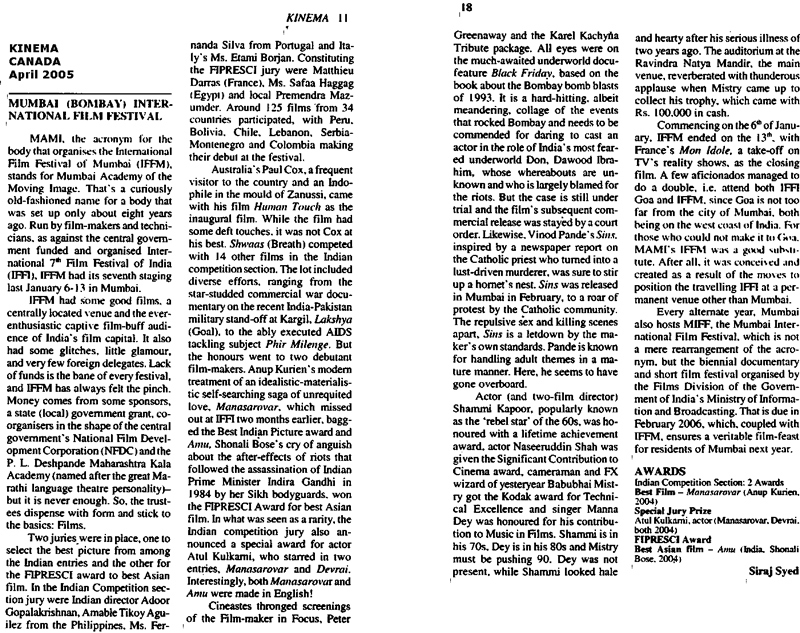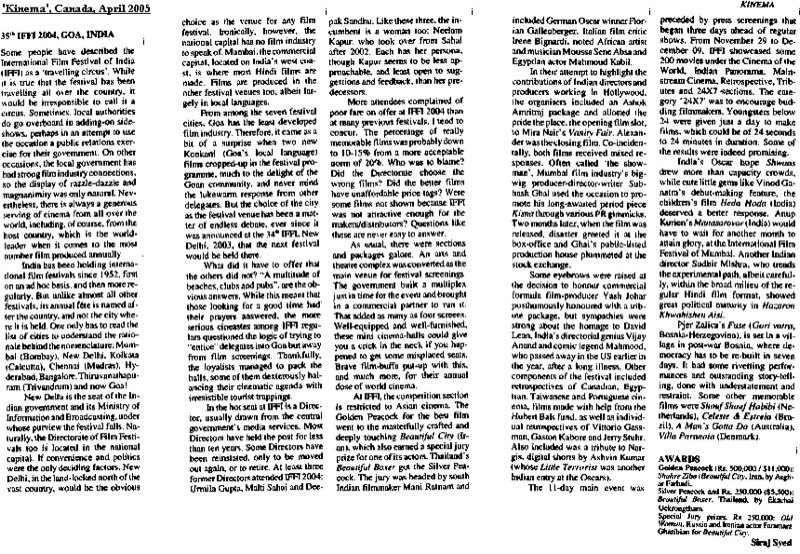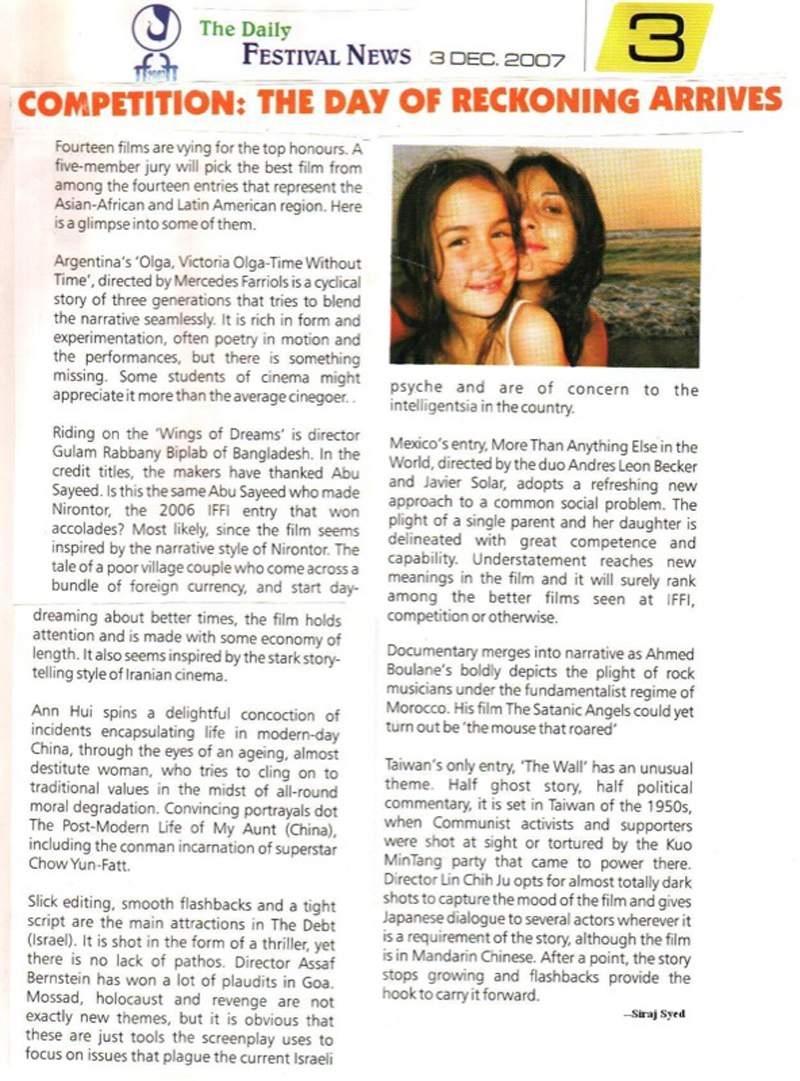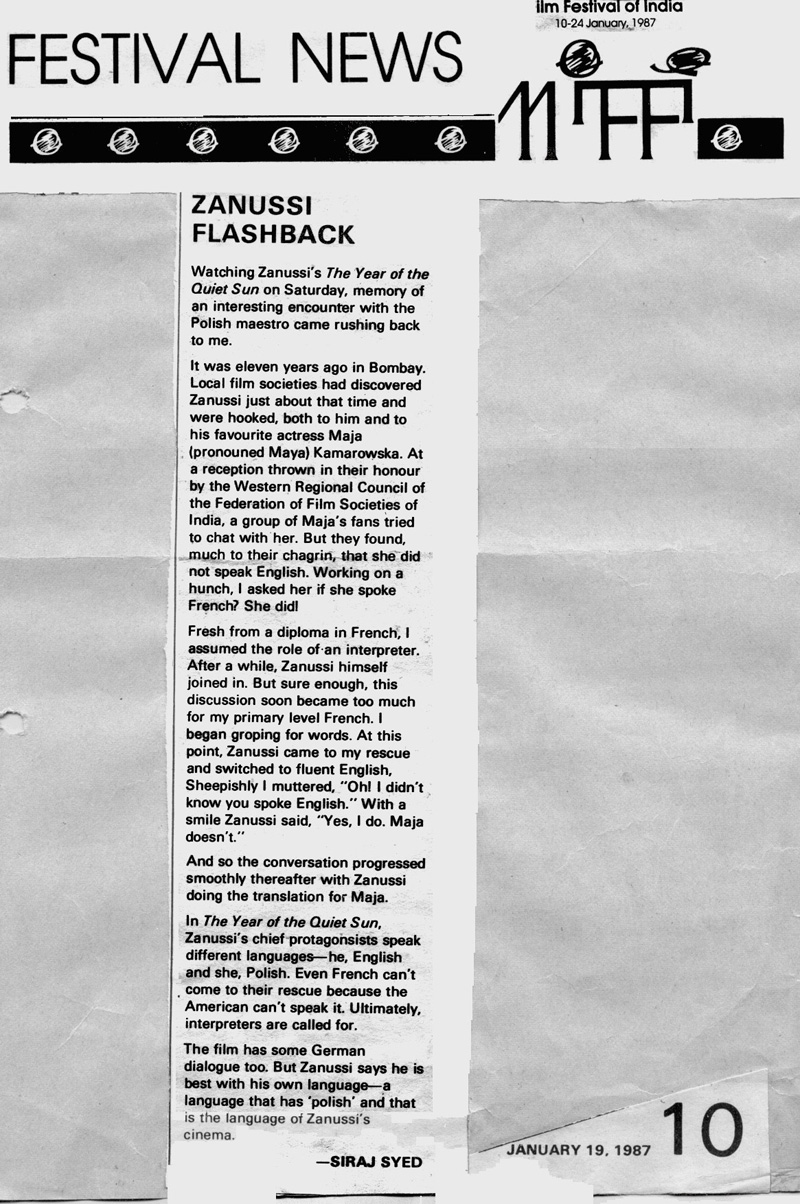|
|
||
|
Pro Tools
FILMFESTIVALS | 24/7 world wide coverageWelcome ! Enjoy the best of both worlds: Film & Festival News, exploring the best of the film festivals community. Launched in 1995, relentlessly connecting films to festivals, documenting and promoting festivals worldwide. Working on an upgrade soon. For collaboration, editorial contributions, or publicity, please send us an email here. User login |
Siraj SyedSiraj Syed is the India Correspondent for FilmFestivals.com and a member of FIPRESCI, the International Federation of Film Critics. He is a Film Festival Correspondent since 1976, Film-critic since 1969 and a Feature-writer since 1970. He is also an acting and dialogue coach. @SirajHSyed  Review of the film PompeiiPompeii Love and Lava As you watch Pompeii, the elements of its screenplay start breaking down: rebellion, sadistic massacre, gladiators and arenas, quest for revenge, love between high and low, white-black man bonding, a villain who will stop at nothing to get the heroine, divine intervention to cleanse the earth of a (debauch) whole city, lovers who are eventually ready to die for each other. Comparison with Titanic is only natural. Director Paul William Scott Anderson (Shopping, Mortal Kombat, Soldier, Event Horizon, the Sight, Resident Evil, Alien v/s Predator) has admitted that “….Ridley Scott or James Cameron… They're gods of film-making.” If Titanic was the inspiration, as it clearly appears, Anderson has taken the idea 1800 years backwards and substituted a whole city for the luxury ship, and lava for the sea. Just as the Titanic symbolised debauchery, greed and vulgar luxury, Anderson plays upon the fact that “Pompeii was an incredibly corrupt city. Pompeii was the Las Vegas of the Roman Empire. It’s where you went for your dirty weekends and debauchery.” An ancient Roman town-city near modern Naples, Italy, Pompeii was mostly destroyed and buried under 4-6 m. of ash and pumice in the eruption of Mount Vesuvius in 79 A.D. At the time of its destruction, 160 years later, its population was around 20,000, with a water system, an amphi-theatre and a port. The site was lost for about 1,500 years, until its initial rediscovery, in 1599 and broader rediscovery later, in 1748. Evidence for the destruction originally came from a surviving letter by a man called Pliny the Younger, who saw the eruption from a distance, and described the death of his uncle Pliny the Elder, an admiral of the Roman fleet. The film gives us a heart-rending quote from this letter. During the excavation, plaster was used to fill in the voids between the ash layers that once held human bodies. This allowed one to see the exact position the person was in when he or she died. Taking off from here, in trade-mark Anderson style, we find odd, tilted, high and low angles as well as slow and fast revolving pull back shots, setting the scene right in the beginning. The film tells the epic story of Milo (Kit Harington), an orphan slave turned invincible gladiator, who finds himself in a race against volcanic eruptions to save his true love Cassia (Emily Browning), the beautiful daughter of a wealthy merchant (Jean-Francois Lachapelle) who has been unwillingly betrothed to a corrupt Roman Senator (Keifer Sutherland). As Mount Vesuvius erupts in a torrent of blazing lava, Milo must fight his way out of the arena, with help from a black brave-heart named Atticus (Adewale Akinnuoye-Agbaje), in order to save his beloved as the once magnificent Pompeii crumbles around him. Four writing credits include the Batchlers (Janet and Lee) and Julian Fellowes, who did the rewrite. The Batchlers are the duo that wrote Smoke and Mirrors, Batman Forever and My Name is Modesty. Their initial draft of Pompeii was the hot script at the 2011 Cannes Film Festival, raising $105 million in 27 hours. And another of their scripts is Galveston, a Romeo-and-Juliet romance set against the harrowing true story of the Galveston hurricane of 1900 -- the biggest disaster of any kind ever to strike the United States! Sounds familiar? While the film is on, the elements serve their purpose and take the story further. Some clever punches have been incorporated, with matching mise-en-scene and editing to match. Sadly, as the film nears the end, you might not find much to take home, except the camerawork and the spectacular 3D pyrotechnics in the overdrawn climax, which could have been shorter. Dialogue is functional, even stilted and claptrap at times, a common pitfall in most historicals. Kit Harington, trained in Speech and Drama and a BA (Hons) in Acting, was seen in Silent Hill-Revelation and Seventh Son. Here, his role required a low level of acting skill, a lot of muscle and some good horse-sense (pun intended). He passes muster. Australian Emily Browning, who was seen in the generous skin-show Australian production Sleeping Beauty but had a more challenging role in Sucker Punch, has a small role and some contrived verbal exchanges with Sutherland. There is little chemistry between the lead pair. Kiefer Sutherland is a strange choice and his performance a little awkward and forced. As a rich merchant in Pompeii, who wants to work his way up the socio-political ladder, Lachapelle plays a grey character. He is not bad. London-born Akinnuoye-Agbaje, of The Mummy Returns, The Bourne Identity, G.I. Joe: The Rise of Cobra and Thor: The Dark World fame, cast here as a kind of ancient Mike Tyson, impresses. In spite of the brawny role, he has a certain dignity about him and, very often, his silence is eloquent. Pompeii is good in parts, but the whole just falls short. Rating: **1/2 20.02.2014 | Siraj Syed's blog Cat. : Love and Lava Hollywood
|
LinksThe Bulletin Board > The Bulletin Board Blog Following News Interview with EFM (Berlin) Director
Interview with IFTA Chairman (AFM)
Interview with Cannes Marche du Film Director
Filmfestivals.com dailies live coverage from > Live from India
Useful links for the indies: > Big files transfer
+ SUBSCRIBE to the weekly Newsletter DealsUser imagesAbout Siraj Syed Syed Siraj Syed Siraj (Siraj Associates) Siraj Syed is a film-critic since 1970 and a Former President of the Freelance Film Journalists' Combine of India.He is the India Correspondent of FilmFestivals.com and a member of FIPRESCI, the international Federation of Film Critics, Munich, GermanySiraj Syed has contributed over 1,015 articles on cinema, international film festivals, conventions, exhibitions, etc., most recently, at IFFI (Goa), MIFF (Mumbai), MFF/MAMI (Mumbai) and CommunicAsia (Singapore). He often edits film festival daily bulletins.He is also an actor and a dubbing artiste. Further, he has been teaching media, acting and dubbing at over 30 institutes in India and Singapore, since 1984.View my profile Send me a message The Editor |


























